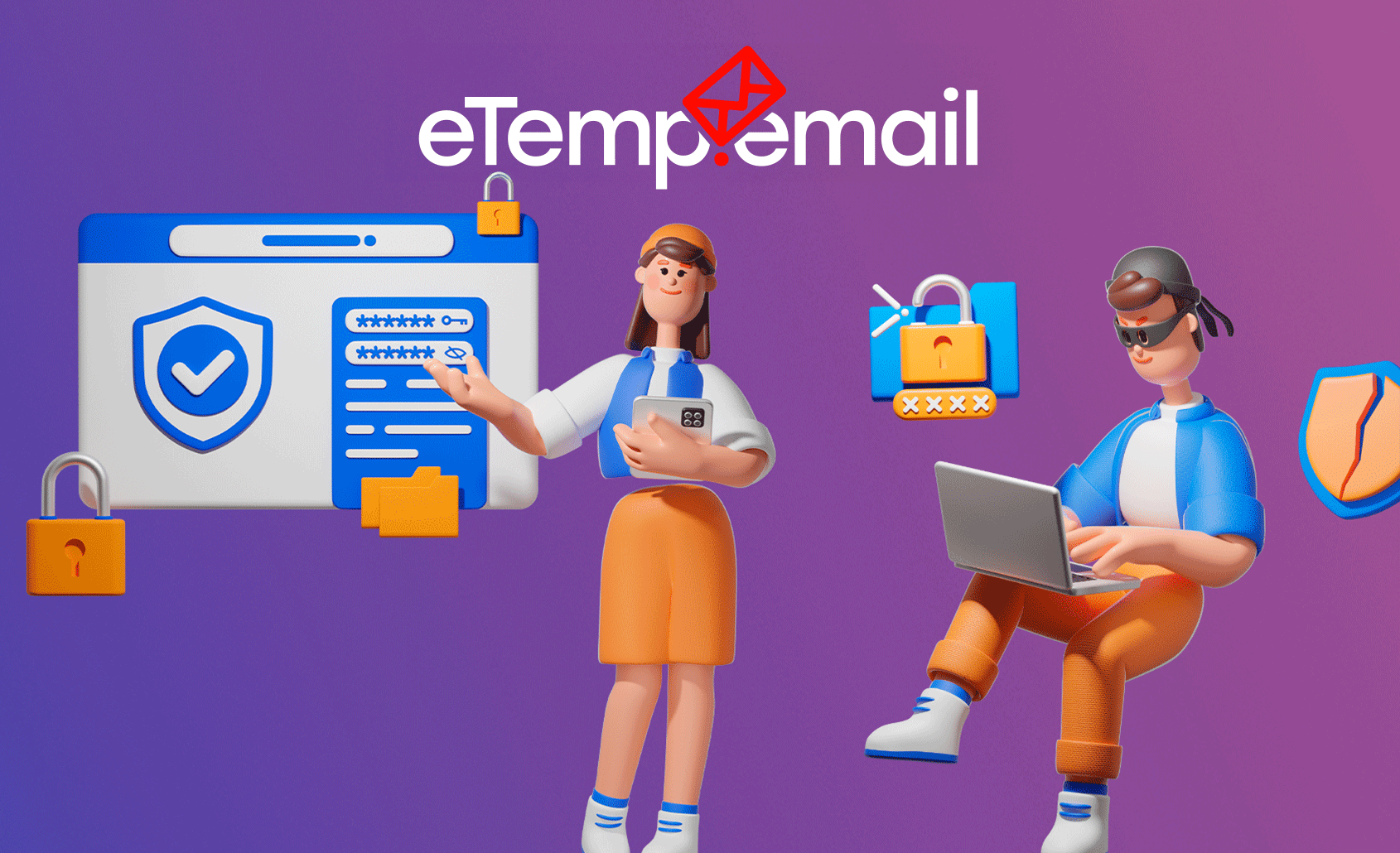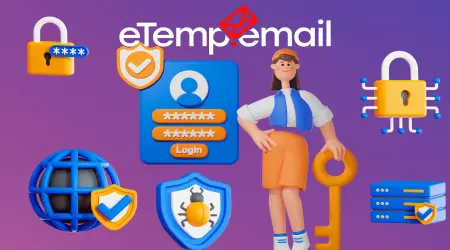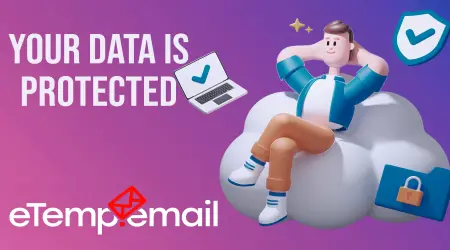

Why You Get Hacked and How to Avoid It: 5 Key Causes of Data Breaches
In 2025, a cyberattack occurs every 39 seconds somewhere in the world. Your accounts could be getting hacked right now, even if you don't notice it. The consequences can be devastating: from financial loss and identity theft to reputational damage. Understanding why you get hacked is the first step toward effective protection. In this article, we'll break down the 5 main causes of data breaches and offer simple yet powerful methods for protecting yourself, including using eTemp.email.
🔍 Why Are You the Target? 5 Main Reasons for Hacking
Your digital security often hinges on the most basic habits and knowledge. Let's look at the key vulnerabilities.
1. Weak and Reused Passwords – Open Doors for Attackers
Statistics are stark:
- 59% of users employ the same password across all their accounts.
- 23% opt for obvious combinations like "123456" or "password."
- Simple passwords can be brute-forced in less than an hour.
The Problem: If a hacker gains access to one of your passwords, they'll try to use it on dozens of other websites. This is known as "credential stuffing."
The Solution:
- Use a password manager: These secure tools generate, store, and auto-fill complex, unique passwords for each of your accounts. Popular options include Bitwarden, LastPass, and KeePass. Our
Password Generator from eTemp.email - Create long, unique passphrases: Instead of short words, use long and unrelated phrases of 12+ characters, such as "BlueHouseGore2024!" or "MyCatLovesToSleepOnTheKeyboard!".
- Never reuse passwords: Create a unique password for every new service or account.
2. Phishing: When You Hand Over Your Own Data
Phishing is a deceptive tactic where attackers impersonate trusted entities (banks, well-known services, government agencies) to trick you into revealing confidential information.
Typical Scenarios:
- An email "from your bank" urgently asking you to log into your account due to suspicious activity.
- An SMS about a blocked card with a fake link to a page mimicking your bank.
- Fake social media login pages or email services that look genuine.
- "Urgent" notifications about package delivery or outstanding debts with a malicious link.
How to Protect Yourself:
- Always check the URL before entering any data. Ensure it starts with
https://(look for the padlock icon in the address bar) and matches the official domain of the organization. For example,faceboook.cominstead offacebook.comis a phishing attempt. - Use
eTemp.email How Disposable Email Addresses Work: A Technical Deep Dive - Enable two-factor authentication (2FA) wherever possible. Even if you accidentally enter your password on a phishing site, attackers won't be able to gain access without the second factor. Read more about this in "
How to Protect Personal Data Online: 5 Simple Steps with eTemp.email
3. Database Leaks – Is Your Information Already Compromised?
Unfortunately, even major companies fall victim to cyberattacks, leading to massive data breaches.
The Facts:
- In 2023, there were over 6,000 major data breaches, affecting billions of records.
- Your logins, passwords, email addresses, and other personal data may already be in the public domain or in the hands of hackers.
- Attackers actively use old data leaks to test new accounts, attempting to reuse stolen credentials.
What to Do:
- Regularly check your email addresses on the Have I Been Pwned website (
https://haveibeenpwned.com/ - Use unique passwords for all important services so that a breach on one site doesn't lead to the compromise of your other accounts.
- Register using
temporary email
4. Malware on Devices – Unseen Threats
Viruses, Trojans, spyware, and other malicious programs can be installed on your computer or smartphone without your knowledge, intercepting data, controlling your actions, or even encrypting your files.
Signs of Danger:
- Unexpected pop-ups or ads.
- Unfamiliar programs in startup lists or installed applications.
- Suspicious activity in your accounts (e.g., emails being sent without your input).
- Slow device performance.
Protective Measures:
- Install reliable antivirus software (e.g., Malwarebytes, Kaspersky Free, Avast) and keep its definitions regularly updated.
- Don't download files from unverified sources: Avoid cracked software, suspicious email attachments, or unofficial app stores.
- Use
temporary email
5. Social Engineering – Manipulating Your Emotions
Social engineering is a hacking method based on psychological manipulation. Hackers use deception to convince you to voluntarily disclose confidential information or perform an action that helps them gain access to your data.
Attack Examples:
- A "call from tech support" demanding your password or an SMS code to "fix a problem."
- Fake contests with "prizes" that require you to enter personal data or pay a "tax" to receive them.
- Fake profiles of friends in messengers asking to borrow money or click a suspicious link.
- Pressure, urgency, threats, or promises of huge benefits.
Safety Rules:
- Never share SMS codes, passwords, or any other sensitive information with anyone, even if they claim to be from your bank or tech support.
- Always verify the caller's or sender's identity: Hang up, find the organization's official number online, and call them back yourself.
- Use alternative contacts for registrations: If you use
temporary email - Be skeptical: Be suspicious of unexpected offers, demands, or messages that evoke strong emotions. Learn more about social media protection in our article "
How to Protect Personal Data on Social Networks: 5 Simple Steps
🛡️ 5 Levels of Protection for Your Accounts
For comprehensive data protection, you need to apply a multi-layered approach:
- Basic Level:
- Unique passwords for each service (using the
Password Generator - Regular password updates (every 3-6 months for important accounts).
- Unique passwords for each service (using the
- Advanced Protection:
- Enable 2FA wherever possible.
- Use of a password manager for secure storage.
- Online Anonymity:
- Register on questionable resources via
eTemp.email - Maintain a separate email for financial transactions and important personal correspondence.
- Register on questionable resources via
- Breach Control:
- Monitor your data online (e.g., via Have I Been Pwned).
- Quickly block and change passwords for compromised accounts.
- Education:
- Learn about new fraud schemes and cyber threats.
- Teach your family and friends the basics of cybersecurity.
💡 Why Is Temporary Email a Must-Have in 2025?
The eTemp.email service solves several key online security issues at once:
- ✔ Protects your primary email from spam: By using a temporary address, you avoid being added to marketing lists and unnecessary databases.
- ✔ Allows you to register anonymously on websites: You maintain your privacy without revealing personal details.
- ✔ Automatically deletes correspondence history: After a set period (e.g., 24 hours), all data self-destructs, leaving no traces.
- ✔ Requires no account creation: Instant access without the need to register or provide personal information.
Usage Example: Do you need to download a file from an obscure forum, but it requires registration? Use a
🚀 Conclusion: How Not to Fall Victim to Hackers
In 2025, internet security isn't a luxury; it's a necessity. Your digital life depends on your habits. To minimize the risks of hacking and data breaches:
- Never use the same password for multiple accounts.
- Always enable two-factor authentication wherever possible.
- Regularly check your data for breaches and react promptly.
- Install reliable antivirus software and be vigilant when downloading files.
- Use
eTemp.email
Remember: 90% of your online safety depends on your habits and awareness. Start applying these rules today, and your data will stay protected.




